Why Public Education is Worth Fighting For – 10 Strategies That Help Us Stay Solutions-Oriented Problem-Solvers
11/18/2021
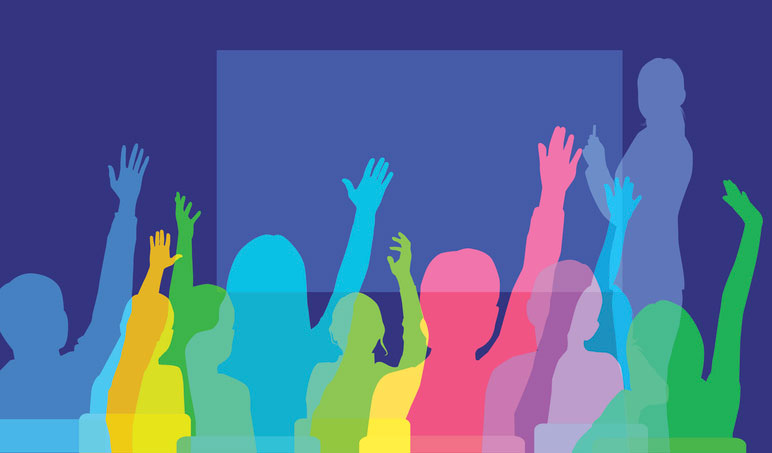
Part 2 in a 3-Part Series - In this three-part series, we will explore the current fight to maintain public education, outline some strategies for ways we can improve the current situation, and look at some of the people that have made strides in the fight to save public education across the nation.
If you are a public educator, your stomach has probably been churning the past year, the stress you feel is real! What is happening to the institution that we once thought was the greatest American achievement...free public education for all? Public education has been scrutinized, attacked, and abandoned by many families. Even the leaders of many state education departments are seemingly dividing and destroying the essential fabric in which public education was created.
"Don't sniff the turd," is a great quote from one of my favorite "frentors" ("frentor" is a friend that is also a mentor). My "frentor," Denny McLaughlin (www.hightrust.net), goes further into how society is infatuated with admiring the problem or the "turd." He believes the faster you can "go to solution," the healthier you or your system are when dealing with problems.
Some people love the "problem." They can tell the problem stinks, they love talking about it, and I would go as far saying they may even admire the problem. They poke, kick it, move it to another location, but they never tackle a solution to get rid of it. You know these people, they love drama and it tends to follow them, especially when they only focus on the problem.
As a superintendent, I feel a major portion of my job is solving problems. As many educators may know, as you climb the job ladder in education, you tend to be less connected to students. As a new superintendent, I have found it difficult to be in classrooms every day which makes it harder to connect and form relationships with students. In fact, there may even be days I don't set foot in a school.
I believe in order to create strong relationships and stay grounded with my school system, I must find ways to stay connected with staff, students, and the community. One of my goals this year is to be in school every day. I am happy to announce that I have hit that goal with about 95% success rate in the first quarter of the school year.
What I Learned from a Day of "Renting" My Services to Students and Faculty
Another idea I have implemented to connect with students and staff is called, "Rent-a-Supt." This is modeled after an idea I found on the Principal's Principles Facebook Page, "Rent a Principal." One day each semester, I allow all teachers (PreK-12, Driver's Education to Kindergarten, etc.) to sign up to rent my services for an hour. I give them some examples of how I can support their classrooms from teaching a lesson, team teaching with the teacher, participate as a student, work with students, correct papers, run errands, or pretty much anything else they request.
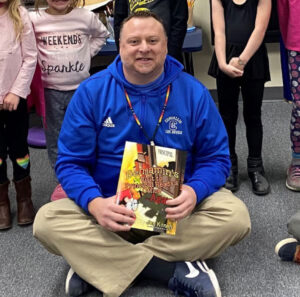 Here is my Rent-a-Supt schedule this past week:
Here is my Rent-a-Supt schedule this past week:
8:00- 9:00 Kindergarten - Read a story, start discussion, and answer questions.
9:00-10:00 First Grade - Supported students with Read Naturally assessments and read another story to them.
10:00-11:00 High School Algebra - Played a dice game with students on graphing x and y slope, and connected this math to my vast roller coaster experiences.
11:00-12:00 High School Science: Classroom Without Walls - Went to the Teller Wildlife Refuge (Corvallis, Montana) where I was able to work with students on gathering data on macroinvertebrates by taking water samples from Woodside Creek and Gird Creek in the Bitterroot Valley.
1:30-2:30 Sixth Grade - I taught a math lesson titled, Mr. Konen's Magnificent Math Problem, with six graders.
2:30-3:00 First Grade - I met with a first grade classroom to work on reading scripts for an upcoming Thanksgiving play adapted from the book, Twas the Night Before Thanksgiving, by Dav Pilkey.
While the world seems to be quarreling about anything and everything, I am embracing a more proactive and beneficial approach to solving problems. In fact, I believe the experience I had this past week with my "Rent-a-Supt Day" gave me insight into a list of 10 strategies that support this approach to fight for Public Education (*though these experiences may be found in private and charter schools, public schools do it by enrolling everyone without restrictions).
1 - Engaging Emotionally, Behaviorally, and Academically
Public educators teach all students. We must create support systems that provide accommodations, modifications, and interventions to meet all students where they are emotionally, behaviorally, and academically. We must do so by engaging emotionally, before we can successfully engage behaviorally or academically.
We must create support systems that provide accommodations, modifications, and interventions to meet all students where they are emotionally, behaviorally, and academically.
In my experience, I saw teachers at the primary, middle school, and high school levels working on relationships first. Teachers used positive words, hugs, handshakes, smiles, kindness, and empathy in order to connect with students.
2 - Hands on Learning Outside
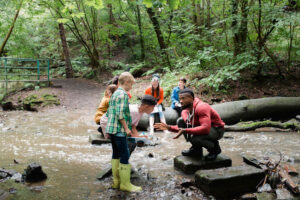 Allowing all students to access the classroom outside of the school's walls is amazing and positively impacts learning. The interaction with real world experiences together with a classroom teacher who is knowledgeable in the learning targets makes hands-on learning outside important to a student's success.
Allowing all students to access the classroom outside of the school's walls is amazing and positively impacts learning. The interaction with real world experiences together with a classroom teacher who is knowledgeable in the learning targets makes hands-on learning outside important to a student's success.
In my experience, I saw an amazing teacher working alongside a group of 25 students. They collected water samples from two creeks located five minutes from school. Students used donated water gear that got them into the creeks and then used specialized nets and other devices to collect macroinvertebrates. The teacher was continually teaching and facilitating this hands-on learning experience.
3 - Teachers that Empower Students
Most educators, and I would venture to state that all educators, believe in the gradual release of responsibility when working with students. If we expect it, we must teach it. If they are not ready to complete a task, we must continue to teach it. The goal is for students to gradually take over more of their own learning, or develop agency. We want students to understand how to find resources, ask for support, and problem solve. This process is gradual as some students need more support than others. This gradual release is developmental.
In my experience, I saw teachers from kindergarten to twelfth grade that differentiated their level of support for classrooms as well as individual students. Within minutes I could tell what the teacher was working on with specific students, and even small groups of students. To the uniformed observer, this empowerment may go unnoticed!
4 - Collaborative Teaming with Colleagues
 We are better together than by ourselves. Research and data for decades has supported the idea that we can support our students at higher levels when we can team together. The professional learning community concept can tackle most, if not all, education problems as we are bringing multiple brains together to "go to solution." The ability to team with our colleagues can be in all domains of engagement as mentioned in idea #1 above: academically, emotionally, and behaviorally.
We are better together than by ourselves. Research and data for decades has supported the idea that we can support our students at higher levels when we can team together. The professional learning community concept can tackle most, if not all, education problems as we are bringing multiple brains together to "go to solution." The ability to team with our colleagues can be in all domains of engagement as mentioned in idea #1 above: academically, emotionally, and behaviorally.
In my experience, I saw teachers teaming together to support students. They planned instruction and learning experiences that were similar among classrooms. I also saw team teaching in a classroom where the two teachers had to be on the same page with how they were going to support the students seated in front of them. I also saw a teacher connect to other content areas outside of their respective classroom.
5 - Powerful Learning Experiences that Are Remembered
When you think back to your own education, you may only remember teachers and not so much the assignments. Great educators create learning experiences that are remembered. In fact, the learning experiences that you do remember probably are directly connected with a teacher you respected. Try thinking of a great learning experience you had from a teacher in which you disliked, hard to do isn't it? Impactful learning experiences connect and engage students emotionally and academically.
Impactful learning experiences connect and engage students emotionally and academically.
In my experience, I saw students working on props and scripts for a play about Thanksgiving. I also saw students putting on waiters to jump into creeks to collect bugs, students and teachers playing educational games that support learning, and teachers connecting content with strong relationships.
6 - Technology Equipped for the Future
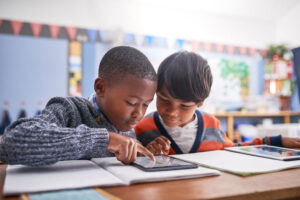 It is hard to believe where we will be in five to ten years with technology in education, but who would have believed all public schools would change to remote learning and do so in less than a month. These types of technological advances have moved education learning experiences faster than at any other time in history. Students are learning both synchronously and asynchronously platforms. It is hard to find any job that doesn't involve technology in some fashion. This technology has definitely changed the way we teach and learn. The most effective teachers embrace it and are willing to learn right alongside the students.
It is hard to believe where we will be in five to ten years with technology in education, but who would have believed all public schools would change to remote learning and do so in less than a month. These types of technological advances have moved education learning experiences faster than at any other time in history. Students are learning both synchronously and asynchronously platforms. It is hard to find any job that doesn't involve technology in some fashion. This technology has definitely changed the way we teach and learn. The most effective teachers embrace it and are willing to learn right alongside the students.
In my experience, I saw students using handheld devices to listen to stories, working on chromebooks using Google Classroom, using technology that supports both visual and verbal learners, and using software that collects data and analyzes it.
7 - Not Afraid of Assessment, Always Tracking Progress
There is growing sentiment over the past two decades that we are testing our students too much. The amount of time students spend on testing is extensive. Let's set the record straight, the best teachers are assessing daily with formative assessments and are not afraid of assessing. They know more about their students through these formative assessments than from the once a year required state and federal testing. Educators know that the best data is collected before, during and after instruction. That data is then used to change instruction immediately. In fact, the best educators can pinpoint exactly what their students are missing, what they need now to fill the gaps or holes they have, and where they need to go in the future.
In my experience, I saw students doing cold and hot reads for formative reading assessments, students self assessing their learning, and teachers connecting individually with each student on their learning.
8 - Telling Our Story by Celebrating Learning
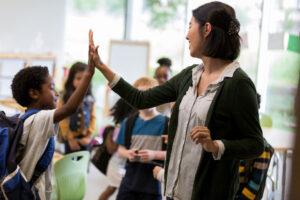 The number one strategy I believe to fight the anti-public school sentiment is the ability to tell our story by celebrating the great things going on in our classrooms. I believe if all classrooms were expected to tell their story daily through pictures and words, the story would be so loud and positive we wouldn't be in this current situation. Social media, newsletter, videos, and other publications are being used more than ever in our public schools, but I believe the volume can be increased!
The number one strategy I believe to fight the anti-public school sentiment is the ability to tell our story by celebrating the great things going on in our classrooms. I believe if all classrooms were expected to tell their story daily through pictures and words, the story would be so loud and positive we wouldn't be in this current situation. Social media, newsletter, videos, and other publications are being used more than ever in our public schools, but I believe the volume can be increased!
I believe if all classrooms were expected to tell their story daily through pictures and words, the story would be so loud and positive we wouldn't be in this current situation.
In my experience, I saw teachers documenting learning with pictures and words. The outdoor science class even gave a specific job to a student to document the learning with a camera taking pictures. This freed up the teacher to facilitate learning. You could tell the student photographer had specific instructions on how to document learning. By the end of my experience, I saw posts were created for social media, as well as a mention that pictures were going to be placed into the High School Annual.
9 - Serving and Connecting with the Community
Schools in many communities are the hub for most everything. In fact, in most communities the public schools are usually one of the largest employers, as well as one of the biggest investors back into the local organizations and businesses. Giving back by serving and connecting with the community supports the need for strong public schools. Unique ideas to support our communities are continually being sought after to enhance the learning for all students, as well as benefiting the communities. The most effective teachers and schools model understand this and are giving back to our community which in turn creates a sense of pride for everyone.
In my experience, I saw teachers creating learning that invited families into the school, informed the community of the stream health in the valley, communicated with parents on student progress, and other ideas to connect the community.
10 - Effective and Inspirational Instructional Leadership that Levels the Playing Field
 Educational leaders can be teacher-leaders, principals, or directors. Everyone plays a role in student. Changing our perspective to focus on how we can improve student achievement, the best schools emphasize instructional leadership when meeting their goals. Celebrating and telling the story of these amazing educational leaders is important to understanding the vision for student learning and achievement in each community. The leaders that understand this achieve at levels they have not done so previously, and they do this by leveling the playfield for students, as well as teachers. Public schools take all students; they are not selective in who they enroll. They mirror our society and give students the best learning experiences for what life looks like after public school education.
Educational leaders can be teacher-leaders, principals, or directors. Everyone plays a role in student. Changing our perspective to focus on how we can improve student achievement, the best schools emphasize instructional leadership when meeting their goals. Celebrating and telling the story of these amazing educational leaders is important to understanding the vision for student learning and achievement in each community. The leaders that understand this achieve at levels they have not done so previously, and they do this by leveling the playfield for students, as well as teachers. Public schools take all students; they are not selective in who they enroll. They mirror our society and give students the best learning experiences for what life looks like after public school education.
Celebrating and telling the story of these amazing educational leaders is important to understanding the vision for student learning and achievement in each community.
In my experience, I saw principals supporting students before school, in the hallways, as well as in their offices. I saw educational leaders supporting teachers in the trenches where they work. I saw team leaders connecting to the rest of their grade level teams. All was done to support students and level the playing field for all!
Become part of the solution by learning how to become a teacher.
In part two of this three part series, I have given 10 strategies to develop, communicate, and celebrate the great things going on in public education. In the last of the three part series, we will explore some of the people who are on the same crusade to fight for public education and how you can help the cause.
- Learning How to Say No and Set Boundaries with Parents - November 21, 2022
- If You Had Only One Behavior Strategy to Use in Your Classroom, What Would It Be? - September 26, 2022
- Live Your Code: 7 Strategies That Will Help You Be the Most Effective Educator You Can Be - August 15, 2022









